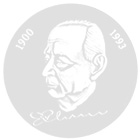Invention of highly efficient organic semiconductor devices
Pioneer of Organic Electronics
After the successful introduction of initially voluminous cathode ray tube based televisions, the vision of a flat electronic window to the world that can be hung on a wall like a picture emerged at the end of the fifties of the twentieth century. Although this vision, which was shared by Eduard Rhein, has become a reality due to the important developments of previous technology award recipients in the area of liquid crystal technologies, many challenges still remain. Besides further reduction of display thickness and power consumption which is essential for mobile end devices, further improvements of image quality parameters such as contrast and color space, as well as improvement of switching speeds in the case of 3D displays or the possibility to realize mechanically flexible or even rollable video displays are desired. All of these requirements can be met in a nearly ideal fashion by self emitting displays consisting of organic light emitting diodes that are deposited on large areas. On top of this, the development of highly efficient organic diodes also enables realization of cost efficient and mechanically flexible photovoltaic cells, which represent another attractive application of organic electronics.
The discovery of electrically conducting polymers by Heeger, Mac Diarmid and Shirakawa was an important milestone for the development of organic electronics, which was awarded by the Nobel committee for chemistry in 2000. The conductivity of organic materials is based on molecular orbits, which represent the geometrical shape of electron waves and extend along the entire organic molecule, as well as on charge hopping processes between neighboring molecules. The molecule orbital which is fully filled with electrons of the highest energy (highest occupied molecular orbit, HOMO) and the unfilled molecular orbital with the lowest energy (lowest unoccupied molecular orbit, LUMO) have a similar function as the valence and conduction band in conventional solid state electronics. Some organic materials with an appropriate energy distance between LUMO and HOMO exhibit semiconducting properties, which enables the realization of organic semiconducting devices such as diodes and transistors. In contrast to conventional inorganic semiconductors made from costly single crystals, organic semiconductors can be deposited on arbitrarily big substrates by comparatively simple evaporation or coatings from solutions (similar to lacquer coatings). This is a necessary prerequisite for cost efficient realization of large area applications such as displays and photovoltaic cells.
First experiments about electroluminescence in organic materials have already been made in the sixties. Due to the low charge carrier mobilities and the resulting low conductivities about hundred volts were needed to drive the several millimeter thick organic layers. In contrast this years award winner used multilayer stacks of evaporated extremely thin organic layers in his experiments which were performed in the mid eighties in the Kodak research laboratories, thus yielding organic photovoltaic cells with significantly improved conversion efficiencies compared to previous single layer devices. Building on this competence, Prof. Tang and his co-worker Van Slyke successfully realized the first highly efficient organic light emitting diode in 1987. The achieved reduction of the supply voltage below ten volts corresponds to a remarkable improvement of the device efficiency of more than one order of magnitude, thus demonstrating practically usable luminances at comparatively low power consumption for the first time. The publication of these revolutionary results, which was cited more than 2500 times, created outstanding worldwide interest and represents the starting point for intensive research efforts in numerous academic and industrial research institutions.
Within a wide margin, the light emission is directly proportional to the current flowing through the organic light emitting diode, thus enabling realization of nearly perfect black levels and outstanding contrast values. The comparatively small bandwidth emission of the primary colors enables excellent color performance, while the electro-optic principle of operation also provides micro second response times. The small layer stack thickness of less than a micro meter enables extremely thin setups and even the application on flexible substrates. In the meantime, numerous challenges in the area of mass fabrication have been solved beside sustained improvements of efficiencies and lifetime. In the meantime, displays with organic light emitting diodes achieve a worldwide sales volume of about 10 billion US $, although predominantly only small displays for mobile end devices are manufactured in large quantities. First large area televisions are shipped since the spring of 2013, although still in small quantities. Illumination is another very attractive application for the electroluminescence of organic materials. Organic light emitting diodes enable the realization of extremely thin and large area emitting devices in contrast to competing technologies. Forecasts predict a nearly exponential growth to a world market volume of approximately 5 billion US $ in the coming five years. On top of that, intensive world wide efforts are made to introduce commercial organic photovoltaic cells, enabling entirely new application areas due to the immanent potential for cost efficient mass fabrication.
This years award winner, Prof. Ching W. Tang, has not only given the decisive impulse for all these developments but also been instrumental for the continuous improvement of highly efficient organic semiconductor devices in the past twenty five years. Numerous prizes and awards such as the Jan Rajchman Prize of the Society for Information Display (2001) and the Wolf Prize for chemistry (2011), are documenting the worldwide recognition of Prof. Tang’s work.
The Eduard Rhein Foundation honors Prof. Ching W. Tang as an internationally renowned pioneer of organic electronics, who has created the foundation for revolutionary new types of displays and illuminations.
Prof. Dr.-Ing. Norbert Fruehauf
Stuttgart University
